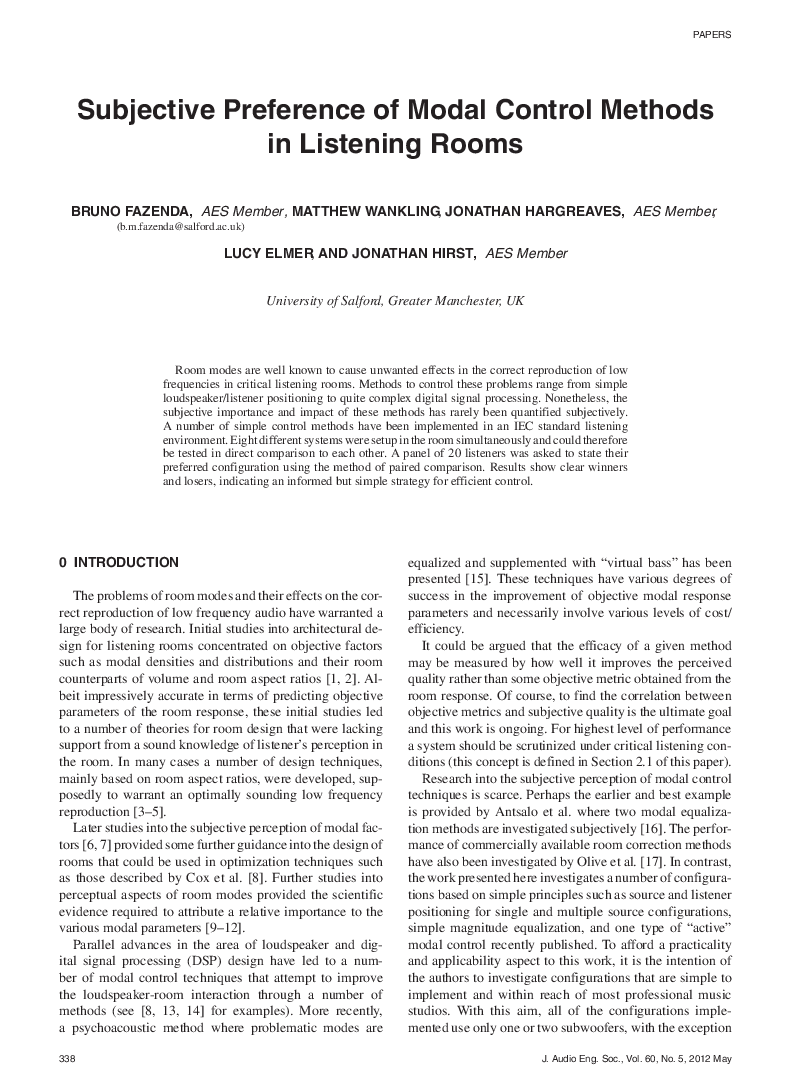Home / Publications / E-library page
You are currently logged in as an
Institutional Subscriber.
If you would like to logout,
please click on the button below.
Home / Publications / E-library page
Only AES members and Institutional Journal Subscribers can download
Methods to control the unwanted effects of low-frequency modes in critical listening rooms range from complex signal processing to the positioning of loudspeakers and listeners. A rigorous scientific experiment has been conducted to evaluate the perceived quality of eight low-frequency reproduction systems used to control the unwanted effects of room modes in a standard listening room. A strong correlation has been demonstrated between perceived improvements in quality and the decay times of low-frequency energy. For critical listening conditions, those systems ensuring a faster decay of low-frequency energy are preferred over those attempting to “flatten” the magnitude frequency response.
Author (s): Fazenda, Bruno; Wankling, Matthew; Hargreaves, Jonathan; Elmer, Lucy; Hirst, Jonathan
Affiliation:
University of Salford, Greater Manchester, UK
(See document for exact affiliation information.)
Publication Date:
2012-05-06
Import into BibTeX
Permalink: https://aes2.org/publications/elibrary-page/?id=16324
(765KB)
Click to purchase paper as a non-member or login as an AES member. If your company or school subscribes to the E-Library then switch to the institutional version. If you are not an AES member Join the AES. If you need to check your member status, login to the Member Portal.

Fazenda, Bruno; Wankling, Matthew; Hargreaves, Jonathan; Elmer, Lucy; Hirst, Jonathan; 2012; Subjective Preference of Modal Control Methods in Listening Rooms [PDF]; University of Salford, Greater Manchester, UK; Paper ; Available from: https://aes2.org/publications/elibrary-page/?id=16324
Fazenda, Bruno; Wankling, Matthew; Hargreaves, Jonathan; Elmer, Lucy; Hirst, Jonathan; Subjective Preference of Modal Control Methods in Listening Rooms [PDF]; University of Salford, Greater Manchester, UK; Paper ; 2012 Available: https://aes2.org/publications/elibrary-page/?id=16324
@article{fazenda2012subjective,
author={fazenda bruno and wankling matthew and hargreaves jonathan and elmer lucy and hirst jonathan},
journal={journal of the audio engineering society},
title={subjective preference of modal control methods in listening rooms},
year={2012},
volume={60},
issue={5},
pages={338-349},
month={june},}